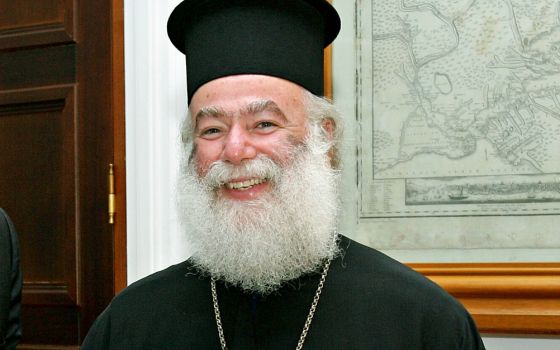 ORDINATION OF WOMEN TO THE DIACONATE IN THE EASTERN CHURCHES: ESSAYS BY CIPRIANO VAGAGGINI
ORDINATION OF WOMEN TO THE DIACONATE IN THE EASTERN CHURCHES: ESSAYS BY CIPRIANO VAGAGGINI
Edited by Phyllis Zagano
Published by Liturgical Press, $9.95
This fine translation of two of Cipriano Vagaggini's essays on women's ordination to the diaconate in the Eastern traditions is Phyllis Zagano's latest of many important contributions to our understanding of the ordination of women to ecclesiastical office in early Christianity.
Here, Zagano -- with the help of Carmela Leonforte-Plimack, Amanda Quantz, and Jesuit Fr. Robert F. Taft* -- translates into English two previously untranslated but seminal essays by Vagaggini. In 1974, Vagaggini, at the time a member of the International Theological Commission, wrote a long essay at the request of Pope Paul VI on the ordination of deaconesses in the Greek and Byzantine traditions. The pontiff was contemplating the possibility of admitting women to the ordained diaconate.
Vagaggini concluded in his lengthy and profoundly researched essay that women in the East had been ordained to the major order of the diaconate over many centuries and in different regions of the Greek and Byzantine churches. He also discussed the liturgies used to ordain women (virtually identical to those used to ordain men to the diaconate).
In his magisterial biography of Paul VI, Peter Hebblethwaite speculates that the International Theological Commission suppressed Vagaggini's article. This is not impossible, as Vagaggini had concluded, quite emphatically, that women could not only be ordained to the diaconate but that their ordination was, in every respect (like dignity), the equal of male ordination to that order, even if the work women did was quite different than that undertaken by male deacons.
It would be hard to exaggerate the scholarly impact of this work. Regrettably, some influential scholars emphatically disagreed with Vagaggini's conclusions. However, recent scholarship has recognized them as based on solid scholarship and reasoning.
A second article in its original form was delivered before the 1987 Synod of Bishops on the laity. (Archbishop Rembert Weakland there also urged that women be allowed to be ordained to all but the priestly ministry.) In the second article, Vagaggini forcefully and convincingly responds to his critics.
The Catholic church's documents on the ordination of women to the diaconate depend on scholarship that Vagaggini and others have since proven false. Since the diaconate exists to this day in the Eastern church, the question of why this 2,000-year-old tradition does not persist in the West, and why its prohibition has been allowed to remain founded on faulty scholarship, remains a pressing and even, to many, a frustrating one.
In August 2013, Pope Francis declared that it was important, even necessary to give women more space (spazio) in the church. A rereading of these two essays by Vagaggini, so masterfully translated, could fortify that papal hope and endow the reintroduction of an ancient tradition with scholarly and historical gravity.
*This book review has been updated to credit those who helped Zagano with translations.
[Kevin Madigan is Winn Professor of Ecclesiastical History at Harvard University and editor and translator, with Carolyn Osiek, of Ordained Women in the Early Church: A Documentary History.]

